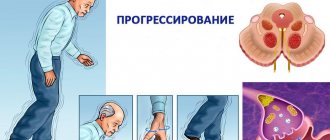History of discovery
British ophthalmologist Warner Tay and American neurologist Bernard Sachs independently described the disease in 1887 and developed diagnostic criteria to distinguish the disease from other neurological disorders with similar symptoms.
Bernard Sachs was the first to hypothesize that this pathology is genetic. His intuitive assumption was confirmed in the mid-twentieth century after the rediscovery of Mendel's laws.
Bernard Sachs proposed a name for the new disease that can also be found in modern medical literature - amaurotic familial idiocy.
What to do?
If you think you have Tay Sachs disease
and the symptoms characteristic of this disease, then doctors can help you: pediatrician, neurologist, geneticist.
We wish everyone good health!
Diseases with similar symptoms
Leukodystrophy (overlapping symptoms: 5 out of 20)
Leukodystrophy is a pathology of neurodegenerative origin, of which there are more than sixty varieties. The disease is characterized by a metabolic disorder, which leads to the accumulation of specific components in the brain or spinal cord that destroy a substance such as myelin.
Did you like the article? Share with friends on social networks:
Causes of the disease
For a long time, doctors could not answer the question of what causes Tay-Sachs disease. The causes of the pathology became known only in the middle of the twentieth century, when ideas about genetics were formed. Studies have shown that the disease develops as a result of a mutation in the HEXA gene, which is located on the 15th chromosome. The disease is a type of GM2 gangliosidosis, a genetic pathology associated with a deficiency or decreased activity of hexosaminidase. Amaurotic idiocy occurs as a result of a decrease in the activity of hexazaminidase A or a deficiency of this enzyme.
The disease is transmitted in an autosomal recessive manner, therefore if a person has a healthy HEXA gene in his genotype, then he does not develop Tay-Sachs disease. The genetics of the disease is similar to the inheritance of such pathologies as Gaucher disease, Urbach-Wiethe disease, Dabin-Johnson syndrome: if both parents were carriers of the mutated gene, the probability of having a sick child is 0.25%, if both mother and father were sick, then both In children, the disease manifests itself in almost 100% of cases.
Some babies may develop a rare genetic disease called Tay-Sachs after birth, which gradually destroys neurons, or nerve cells, in the brain and spinal cord. The disorder has no cure yet, but scientists expect to find a cure in the near future and are betting big on bone marrow transplants and gene therapy.
What is Tay-Sachs disease?
Tay-Sachs disease is an inherited neurodegenerative disorder that is passed from parent to child.
In infants, it is a rare and progressive disease with a fatal outcome. It works when hexosaminidase, the enzyme responsible for the breakdown of fatty components - ganglioside - is absent. They are necessary for the normal development of the nervous system and brain.
Typically, gangliosides are continuously broken down by the enzyme hexosaminidase A to maintain an appropriate balance. But in Tay-Sachs disease, this enzyme (necessary to remove excess gangliosides) is missing. This causes gangliosides to accumulate in the brain, making it difficult for nerves to function and leading to symptoms of the disorder.
Various forms of Tay-Sachs disease
Tay-Sachs disease can take many forms. The most common is infantile , which manifests itself in children around the age of 6 months, after which their development slows down. Infants with the severe infantile form of the disorder usually survive only into early childhood.
Other forms of this disease are quite rare.
Symptoms of Tay-Sachs disease may appear at an older age - from 2 to 5 years, but they are usually not as obvious as with the infantile form. This condition is called juvenile hexosaminidase . The progression of the disease is quite slow and can lead to death between the ages of 5 and 15 years.
There is also a late juvenile or adult form of this disorder , in which symptoms appear in adulthood. It is extremely rare. The life expectancy of people with this disorder may vary.
Another type of Tay-Sachs disease is mild chronic hexosaminidase . Symptoms may begin to appear around the age of 5 and then not occur until the ages of 20 to 30.
Causes of Tay-Sachs disease
Causes of Tay-Sachs disease may include the following:
- A mutation or change in the Hexa gene (a subunit of hexosaminidase A) prevents the body from producing the enzyme hexosaminidase A. A deficiency of this enzyme causes fats called gangliosides to accumulate in the brain, which affects the functioning of the nervous system and causes disease.
- If a child inherits two defective Hex genes, one each from the father and mother, he develops Tay-Sachs disease. If a child receives one mutated gene and the other normal, he turns out to be a carrier. He may not be affected by the disease, but will carry the defective gene and will likely pass it on to his offspring.
Symptoms of Tay-Sachs disease
Some of the common symptoms of infantile Tay-Sachs disease are:
- exaggerated startle response to loud noises;
- hearing loss;
- loss of peripheral vision;
- muscle cramps;
- muscle weakness;
- decreased mental function;
- cherry red spot in the eye;
- slurred speech;
- lack of muscle coordination;
- lack of coordinated movements when crawling, turning over, sitting.
Symptoms of other forms of Tay-Sachs disease
Symptoms of other forms of Tay-Sachs disease can vary greatly. Some of them:
- difficulty breathing and swallowing;
- unsteady gait;
- loss of vision;
- convulsions;
- paralysis;
- cognitive impairment.
Diagnostics and tests
To diagnose Tay-Sachs disease, a prenatal chorionic villus sampling (CVS) test is performed between 10 and 12 weeks of pregnancy, during which samples of cells are removed from the placenta.
Amniocentesis is another test that is usually done around 15 to 20 weeks of pregnancy. It involves sampling amniotic fluid and helps determine the frequency of this disorder.
Genetic testing of parents is done to determine whether they are carriers of Tay-Sachs disease. If a child develops symptoms of the disease, the doctor may first ask about the family history. He may also do a physical examination of the child's eyes to check for cherry red spots, which are one of the characteristic symptoms of Tay-Sachs disease disorder.
The child may also be prescribed an enzymatic test of tissue or blood samples, which examines the presence and level of hexosaminidase A. In Tay-Sachs disease, these indicators are absent or reduced..
Treatment of Tay-Sachs disease
There is no cure for Tay-Sachs disease. However, some methods help cope with its symptoms. For example, anticonvulsants are used to control tremors.
Other supportive treatment may include the use of chest physical therapy to remove excess mucus from the baby's lungs to relieve breathing problems.
If your child develops difficulty swallowing food or liquids, the doctor may suggest a gastrostomy tube, a feeding device that is inserted through the nose. As an alternative, surgical placement of an esophagogastrostomy tube is possible.
The therapy complex also includes massage, which helps maintain flexibility of joints and muscles.
Prevention of Tay-Sachs disease
Preventing the occurrence of infantile Tay-Sachs disease is difficult because it is hereditary.
Screening tests such as amniocentesis or CVS of pregnant women may be useful in identifying carriers of this disorder.
Diagnostic blood tests are another way to find out whether parents-to-be are carriers of the virus or not.
If a couple has a family history of Tay-Sachs disorder, genetic counseling should be sought before planning a child.
Main forms of the disease
It is customary to distinguish three main forms of the disease. The most common of them is infantile. Children with Tay-Sachs disease develop normally until 6-7 months. After this, a slow but irreversible process of decline in mental and physical abilities begins.
There is also a juvenile form of the disease. Compared to infants, it is less common. Until approximately 3-10 years of age, the child develops in the same way as his peers, but over time, a slow decline in cognitive and motor functions begins, dysarthria, dysphagia, and ataxia develop.
Late-onset Tay-Sachs disease is the rarest form of the disease. The first signs of the disease usually appear after 30 years. However, cases of earlier onset of symptoms (15-18 years) have also been recorded. This form of the disease has the most favorable prognosis, since its progression can be stopped.
Prevention
Prevention of Tay Sachs disease is as follows:
- A married couple must undergo a special examination before conceiving. Based on its results, the presence or absence of mutant genes is determined. If they were found in both parents, then it is recommended not to have children.
- If pregnancy has occurred and the parents know that they are carriers of the mutated gene, then a screening test is performed at the twelfth week. To do this, blood is taken from the placenta. Based on its results, the doctor identifies the presence or absence of such a deviation in the fetus.
Future parents should take care of their health and especially the health of their unborn baby. Therefore, it is necessary to follow all the doctor’s advice and recommendations. Carrying out an examination before conception will enable the child to be healthy.
Symptoms
Regardless of the form of the disease, several main symptoms appear: dysphagia, ataxia, loss of cognitive function, muscle atrophy. If a child under one year of age reacts sharply to sharp sounds, gains weight poorly and cannot relax his muscles, parents should show him to specialists - this is how Tay-Sachs disease begins in infants. Symptoms become increasingly severe. After 6 months, motor activity decreases, the baby loses the ability to sit independently and change position. Blindness gradually develops, hearing decreases, muscles atrophy and complete paralysis of the body develops.
In the juvenile form, in addition to the main symptoms, dysarthria (decreased speech clarity), spasticity, and impaired coordination of movements are observed. There is a gradual loss of cognitive functions - a decrease in memory, attention, and performance. Dementia develops. In the later stages of the disease, seizures appear.
The first symptoms of the adult form of the disease are difficulty swallowing, loss of coordination and dysarthria. Mental disorders similar to the symptoms of schizophrenia (visual and auditory hallucinations, apathy, decreased emotionality) often appear. Without treatment, cognitive function deteriorates. Only for this form of the disease there is an effective treatment that can stop Tay-Sachs disease. The National Guide to Neonatology says that effective methods for diagnosing the adult form of the disease appeared only in the 70s; before that, the disease was considered a childhood disease.
Diagnostics
During the initial examination, the doctor collects an anamnesis of the disease, specifying complaints and the duration of symptoms.
Next, inspection of the skin, palpation and finger tapping of the lumbar region are carried out. The diagnosis of renal failure is made on the basis of the following laboratory and instrumental studies:
- General urine analysis. The method allows you to determine the cause of the disease. An admixture of blood and the presence of red blood cells in the biomaterial indicate urolithiasis, glomerulonephritis, infection, neoplasm or injury. Leukocytes indicate an infectious or autoimmune process. The density of urine may also decrease, protein and waxy cylinders may be present in it.
- Clinical blood test. An increase in leukocytes and ESR indicates an infectious process, and a decrease in the number of red blood cells and hemoglobin in the blood indicates anemia concomitant with renal failure.
- Blood chemistry. An increase in serum urea and creatinine is the main sign of renal failure. These substances are formed during the breakdown of proteins and can be excreted from the body exclusively through urine. A progressive increase in creatinine concentration is the main diagnostic criterion for the severity of the disease. Diabetes mellitus is one of the most common causes of chronic renal failure, however, even without endocrine diseases, with kidney dysfunction there is a tendency to moderate increases in blood glucose. A significant increase in potassium levels accompanies severe renal dysfunction, and a high concentration of uric acid is characteristic of gout and can lead to the development of urolithiasis. Also, in blood tests for renal failure, albumin, calcium are often reduced, triglycerides, alkaline phosphatase, phosphorus and cholesterol are increased.
- Kidney biopsy. In difficult diagnostic cases, a small part of the kidney tissue may be collected, which is subsequently examined through a microscope. The method makes it possible to detect the characteristic histological signs of chronic renal failure - replacement of the glomeruli of the kidneys with scar tissue.
- Ultrasound examination of the pelvic organs. Kidney ultrasound plays an important role in the diagnosis of renal failure. With chronic renal failure, their decrease (wrinkling) is noted along with thinning of the outer layer. The method is also used to detect tumors, stones or cysts.
- Computed and magnetic resonance imaging of the abdominal cavity. A more accurate way to visualize tumors, cysts and stones even smaller than 5 mm.
Establishing diagnosis
Doctors are not always able to make the correct diagnosis when it comes to such a rare pathology as Tay-Sachs disease. The symptoms, genetics and treatment of the disease are being actively studied by specialists. Regardless of the form of the disease, there are several diagnostic procedures that are performed if its presence is suspected. One of them is the determination of the activity of the enzyme hexosaminidase in blood serum, leukocytes or fibroblasts. In patients with Tay-Sachs disease, the activity of hexosaminidase B is always below normal, the enzyme hexosaminidase A is practically absent or its activity is significantly below normal.
Another important diagnostic criterion is the presence of a bright red spot on the cornea of the eye, which can be easily noticed by a therapist or ophthalmologist using an ophthalmoscope. A red spot on the cornea was found in all patients, regardless of age.
Unlike other lysosomal storage diseases (Gaucher disease, Standhoff syndrome, Niemann-Pick disease), Tay-Sachs disease does not cause enlargement of the liver and spleen (hepatosplenomegaly).
Standard Treatments
There is no specific treatment for Tay-Sachs disease. Treatment is aimed at addressing the specific symptoms that occur in each person. Treatment may require the coordinated efforts of a team of specialists. Pediatricians, neurologists, speech therapists, specialists who evaluate and treat hearing problems (audiologists), eye specialists, and other health care providers may need to systematically and comprehensively plan treatment for an affected child. Genetic counseling can be helpful for survivors and their families. Psychosocial support is recommended for the whole family.
Because of the potential for feeding difficulties, infants should be monitored for nutritional status and proper hydration. Nutritional support and supplements may be required, and sometimes a feeding tube may need to be inserted. In addition to nutritional support, a feeding tube may be needed to prevent food, liquid, or other foreign substances from accidentally entering the lungs (aspiration).
Anticonvulsants may be used to treat seizures associated with Tay-Sachs disease, but not in all patients. In addition, a person's type and frequency of attacks may change, requiring a change in the type or dosage of medication.
Treatment
There are currently no drugs to cure Tay-Sachs disease. The symptoms and treatment of the disease are still the subject of scientific research.
The infant form of Tay-Sachs disease is the most dangerous. If a sick child cannot swallow on his own, it is recommended to resort to artificial nutrition; it is impossible to restore physical skills. There are no drugs that can stop or reverse the development of the disease, despite all the efforts of scientists. Sick babies, even if they receive the best care, rarely survive past the age of four.
In the juvenile form of the disease, it is important that the child is constantly under medical supervision. Following the instructions of a specialist and undergoing all necessary medical procedures helps to extend the life of a sick child to 12-16 years.
The adult form of the disease progresses more slowly than others and is often treatable. For mental disorders, patients are prescribed lithium or cesium chloride. Clinical trials have shown that pyrimethamine can significantly slow down, and in rare cases completely stop, the progression of the disease by increasing the activity of hexosaminidase B.
Classification of Tay-Sachs disease
- Child form : after six months after birth, children experience a continuous deterioration in physical and mental abilities: blindness, deafness, cannot swallow. The muscles atrophy and paralysis occurs. Death occurs before the age of 3-4 years.
- Adolescent form : motor-cognitive problems, problems with swallowing (dysphagia), problems with speech (dysarthria), unsteadiness of gait (ataxia), spasticity develop. Patients die before the age of 15-16 years.
- Adult form : occurs between the ages of 25 and 30 years, characterized by gait disturbances and progressive deterioration of neurological functions. Typical symptoms are: problems with swallowing and speech, unsteadiness of gait, decreased cognitive skills, spasticity, and the onset of schizophrenia in the form of psychosis.
Prenatal diagnosis
Modern research makes it possible to determine early in pregnancy whether the child has inherited the mutant HEXA gene from its parents. If both parents are carriers of the disease, it is recommended to perform a chorionic villus biopsy. This is one of the most common prenatal diagnostic procedures, the purpose of which is to identify genetic abnormalities in the fetus. It is carried out at 10-14 weeks of pregnancy. Amniocentesis also gives a clear idea of whether the child is a carrier of the mutated HEXA gene. These procedures have a risk of miscarriage of less than 1%.
In the case of artificial insemination, genetic abnormalities of the fetus can be detected even before it is implanted in the uterus. For this purpose, preimplantation genetic diagnosis is performed, an analogue of prenatal diagnosis. Its main advantage is that the procedure is non-invasive and absolutely safe. It is possible to select only healthy embryos for implantation, thereby reducing the risk of having a child with Tay-Sachs disease to almost zero.
Diagnosis of Tay-Sachs disease in Israel
- Ophthalmoscopy: “cherry” spot of the macula, detected on the retina. This is an area of the retina with increased accumulation of gangliosides in retinal ganglion cells. Thus, it is the cherry spot of the macula that is the part of the retina that provides normal vision.
- Microscopic analysis of neurons : these cells, loaded with gangliosides, are stretched.
- Screening , carried out by two methods: Carrier determination test : determines whether a person is a carrier of 1 copy of the mutation.
- Prenatal testing : Determines whether the fetus has inherited two defective copies of a gene, one each from a parent. This test can be performed by analyzing the activity of the HEXA enzyme in embryonic cells obtained from chorionic villus sampling or amniocentesis. A more accurate test, namely polymerase chain reaction (PCR), can be done to analyze mutations.
- Study of enzymatic activity : the level of hexosaminidase A in blood serum and leukocytes is reduced.
- Polymerase chain reaction : a study of DNA (a substance that contains genetic information located in the nucleus of the body's cells) for the presence of mutations.
Causes of the disease
The causes of the disease lie in disorders at the genetic level that occur in the metabolism of gangliosides. These special lipids, exceeding 300 times the norm, are concentrated in the gray matter of the brain.
Accumulation also occurs in the liver and spleen. The disease is based on a deficiency of one of the types of enzymes that affect lipid metabolism (hexosaminidase A).
The disease occurs in a ratio of 1 in 250,000. This disease mainly affects the population of ethnic groups, for example, the French, whose place of residence is Canada.
Jews from Eastern Europe are also susceptible to the disease, with a higher incidence rate of 1 in 4,000 people.
This disease develops in a child who has inherited two genes with a defect, that is, the disease is inherited in an autosomal recessive manner. What does it mean?
A child inherits genes from dad and mom in equal amounts. If one or both chromosomes of a pair are damaged, then a genetic disease is said to occur. In people with Tay-Sachs disease, both chromosomes in a pair are defective.
This disorder is called a disease with autosomal recessive inheritance. If one of the parents has a defective gene, the baby will be healthy, but with a 50% chance of being a carrier, which jeopardizes the health of his heirs in the future. If both parents have a gene with a defect, there are three possible developments.
There is a 25% chance that a child will be born healthy and will not be a carrier of the gene. In 50% of cases, the baby will be a carrier of the defective gene, but will be born healthy. In 25% of cases, the baby may get two genes with a defect, and he will be born with Tay-Sachs disease.
Risk factors
The driving force for the development of this disease is the gradual accumulation of gangliosides in the nervous system - substances that affect the normal functioning of cells of the nervous system.
All sick children have a damaged gene responsible for the complete synthesis of hexosaminidase enzymes.
A child's body with a congenital disease cannot continuously process fatty substances, so they accumulate and are then deposited in the brain.
This leads to the fact that the activity of nerve cells is blocked and serious consequences occur for the entire body. In the body of a healthy child, gangliosides are constantly synthesized and broken down.








